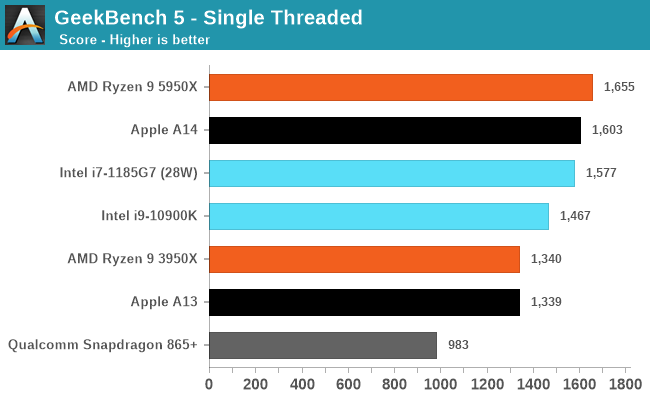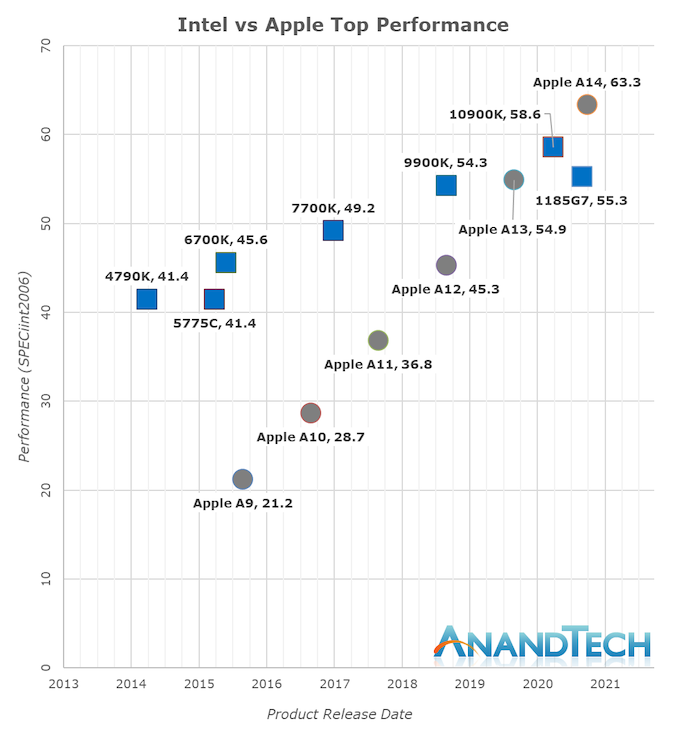Apple Announces The Apple Silicon M1: Ditching x86 - What to Expect, Based on A14
by Andrei Frumusanu on November 10, 2020 3:00 PM EST- Posted in
- Apple
- Apple A14
- Apple Silicon
- Apple M1
From Mobile to Mac: What to Expect?
To date, our performance comparisons for Apple’s chipsets have always been in the context of iPhone reviews, with the juxtaposition to x86 designs being a rather small footnote within the context of the articles. Today’s Apple Silicon launch event completely changes the narrative of what we portray in terms of performance, setting aside the typical apples vs oranges comparisons people usually argument with.
We currently do not have Apple Silicon devices and likely won’t get our hands on them for another few weeks, but we do have the A14, and expect the new Mac chips to be strongly based on the microarchitecture we’re seeing employed in the iPhone designs. Of course, we’re still comparing a phone chip versus a high-end laptop and even a high-end desktop chip, but given the performance numbers, that’s also exactly the point we’re trying to make here, setting the stage as the bare minimum of what Apple could achieve with their new Apple Silicon Mac chips.

The performance numbers of the A14 on this chart is relatively mind-boggling. If I were to release this data with the label of the A14 hidden, one would guess that the data-points came from some other x86 SKU from either AMD or Intel. The fact that the A14 currently competes with the very best top-performance designs that the x86 vendors have on the market today is just an astonishing feat.
Looking into the detailed scores, what again amazes me is the fact that the A14 not only keeps up, but actually beats both these competitors in memory-latency sensitive workloads such as 429.mcf and 471.omnetpp, even though they either have the same memory (i7-1185G7 with LPDDR4X-4266), or desktop-grade memory (5950X with DDR-3200).
Again, disregard the 456.hmmer score advantage of the A14, that’s majorly due to compiler discrepancies, subtract 33% for a more apt comparison figure.

Even in SPECfp which is even more dominated by memory heavy workloads, the A14 not only keeps up, but generally beats the Intel CPU design more often than not. AMD also wouldn’t be looking good if not for the recently released Zen3 design.

In the overall SPEC2006 chart, the A14 is performing absolutely fantastic, taking the lead in absolute performance only falling short of AMD’s recent Ryzen 5000 series.
The fact that Apple is able to achieve this in a total device power consumption of 5W including the SoC, DRAM, and regulators, versus +21W (1185G7) and 49W (5950X) package power figures, without DRAM or regulation, is absolutely mind-blowing.

There’s been a lot of criticism about more common benchmark suites such as GeekBench, but frankly I've found these concerns or arguments to be quite unfounded. The only factual differences between workloads in SPEC and workloads in GB5 is that the latter has less outlier tests which are memory-heavy, meaning it’s more of a CPU benchmark whereas SPEC has more tendency towards CPU+DRAM.
The fact that Apple does well in both workloads is evidence that they have an extremely well-balanced microarchitecture, and that Apple Silicon will be able to scale up to “desktop workloads” in terms of performance without much issue.
Where the Performance Trajectory Finally Intersects
During the release of the A7, people were pretty dismissive of the fact that Apple had called their microarchitecture a desktop-class design. People were also very dismissive of us calling the A11 and A12 reaching near desktop level performance figures a few years back, and today marks an important moment in time for the industry as Apple’s A14 now clearly is able to showcase performance that’s beyond the best that Intel can offer. It’s been a performance trajectory that’s been steadily executing and progressing for years:
Whilst in the past 5 years Intel has managed to increase their best single-thread performance by about 28%, Apple has managed to improve their designs by 198%, or 2.98x (let’s call it 3x) the performance of the Apple A9 of late 2015.
Apple’s performance trajectory and unquestioned execution over these years is what has made Apple Silicon a reality today. Anybody looking at the absurdness of that graph will realise that there simply was no other choice but for Apple to ditch Intel and x86 in favour of their own in-house microarchitecture – staying par for the course would have meant stagnation and worse consumer products.
Today’s announcements only covered Apple’s laptop-class Apple Silicon, whilst we don’t know the details at time of writing as to what Apple will be presenting, Apple’s enormous power efficiency advantage means that the new chip will be able to offer either vastly increased battery life, and/or, vastly increased performance, compared to the current Intel MacBook line-up.
Apple has claimed that they will completely transition their whole consumer line-up to Apple Silicon within two years, which is an indicator that we’ll be seeing a high-TDP many-core design to power a future Mac Pro. If the company is able to continue on their current performance trajectory, it will look extremely impressive.











644 Comments
View All Comments
BedfordTim - Friday, November 13, 2020 - link
The reason is that until recently they weren't good enough, and that there was a chicken and egg situation with software.That changed with the Neoverse cores and you could equally ask why Amazaon and other are now offering ARM servers.
Silver5urfer - Sunday, November 15, 2020 - link
People forget things and people do not know what they are even talking about. Marvell Thunder X3 article right here on AT it was purported to be challenging AMD and Intel. And they abandoned the SKUs for the general purpose meaning, they won't be selling off shelf parts. They will do a custom chip if any company wants them like Graviton for AWS is custom like that Marvell will do for X company per se.And next we go to even further past, Qualcomm Centriq, remember Cloudflare advertisement on the Centriq, they were over the top for that CPU infrastructure. And then what happened ? Fizzled out, Qualcomm axed the whole Engg. Team forever which was the team who made 820 Kryo full custom chip (why did qcomm made full custom ? 810 and 64Bit disaster) and we have Nuvia, Altera, both have to prove themselves, EPYC7742 is the leading champion in the arena right now, Intel is trying so hard to contain the beast of AMD still no viable product, until their 10nmSF is ready.
And here we have people reading this article which has mentioned only GB and Apple graph and then specint perf charts with Single Core performance only and then deciding on Intel and AMD are dead along with x86. Hilarious and even on hackernews, people are discussing some bs medium post on how Intel is going to get shunned...
The world runs on Intel and AMD is just 6.6%, and we have people thinking Samsung and Qualcomm, Huawei are going to come at Intel. Epic joke really. Even more funny part is how Intel Macs are still on Apple.com website at a higher price tag, WHY WILL APPLE STILL KEEP INTEL CPUs IF THIS M1 IS FASTER THAN 5950X and 10900K GOD KNOWS !!!
Sailor23M - Friday, November 13, 2020 - link
^^This. I fully expect Samsung to launch their own Arm chip based laptop and then grow from there to perhaps servers as well.duploxxx - Monday, December 7, 2020 - link
Medium term?You mean people moving to the over expensive eco system of apple because they have a better device that is only compatible with 5-10% of the available sw?
Moving away from x86 neither that will happen. But only for the parts that are written for mobile devices. Back end sw is not just shifting over. Arm servers are evolving but far from x86 portfolio. Only amazon is showing some progress in there own platform which they offer very cheap to bring people over. Those who dev in cloud look into future portability and complain e. Much to discuss about that.
SarahKerrigan - Tuesday, November 10, 2020 - link
The number of in-flight loads and stores the Firestorm core can sustain is just crazy.lilmoe - Tuesday, November 10, 2020 - link
Numbers are looking great for Zen3. ARM X1 should also give Firestorm a run for its money. That being said, the key advantage of the M1 platform will be its more advanced co-processors, coupled with mainstream adoption, should drive devs to build highly optimized apps that run circles around any CPU bound workload... Sure NVidia has Cuda, but it won't be nearly as wide-spread as the M1, and not nearly as efficient. If done right, you can saw bye-bye to CPU-first compute.Ppietra - Tuesday, November 10, 2020 - link
considering what is known ARM X1 will still be quite behindKurosaki - Tuesday, November 10, 2020 - link
Yes, several generations behind, but Intel would still be worse. Crazy world nowadays! :DMgradon - Tuesday, November 10, 2020 - link
Well, it is not the question of CPU speed only. PowerPC was better then Intel but this did not help Apple. Moving the code of all key software to native Apple OS code will take long time, and in virtual mode speed of those CPUs will be low. I am using now MacBook Pro, do I want to be like a beta tester with OS based on IPhone ecosystem - not really convinced.Kilnk - Tuesday, November 10, 2020 - link
Apple reports that graphics-intensive apps run faster on Rosetta on this chip than they were running natively on previous Macs with integrated graphics. It's in the keynote at 18:26. That's how fast it is.